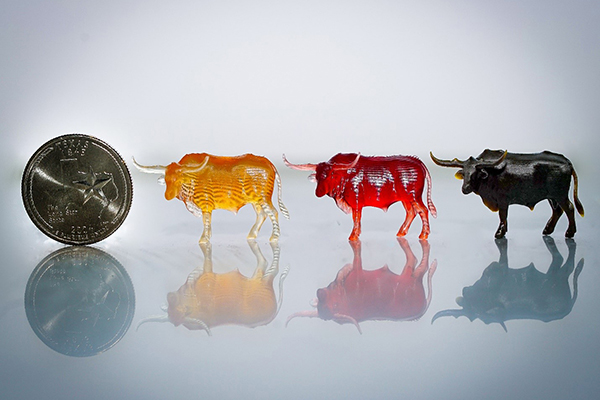UT scientists have developed a low-cost alternative to traditional 3D printing using LED lights, which could be used in printing living cells.
Chemistry assistant professor Zachariah Page and a team of researchers developed a resin that can be used in a method called stereolithography, a light-based 3D printing technique. Page said the method is a low cost, timely and energy efficient way to print 3D objects using multicolored LED lights. Page’s team demonstrated the technology by printing miniature Longhorns.
“Ultimately, it came down to a specific mixture of reagents that interacted energetically and generated the reactive species we needed upon absorbing visible light to cause a very fast solidification process,” Page said.
The team shined a 2D image they wanted to print in 3D into a resin bath. The LED light projects through a series of mirrors to create a pattern on the bottom of the resin, chemistry graduate student Lynn Stevens said.
“Polymerization will only occur in the areas where light is coming in, and so that happens layer by layer with the different pattern that we choose to print for each slice,” Stevens said.
The mechanism dunks the build platform into the liquid resin, creating an extremely small gap for the liquid resin to solidify between, Page said.
“You have these repeating patterns, and you're converting the liquid into a solid,” Page said.
Similar to how a movie moves frame by frame, the build platform moves layer by layer until the 3D object is printed, Page said.
Page said 3D printing has a history at UT-Austin, as one of the first 3D printing technologies using UV rays was developed at UT in the 1980s.
Page said the team is still hoping to use other colors of LED lights in order to activate wavelength-specific reactions, which can create multifunctional 3D objects that can be used in different locations.
Chemistry junior Kevin Zhou said this method of LED light 3D printing can be used in the future for tasks such as bioprinting cells. Zhou said there are some limitations to UV light that LED light does not have.
“The light-based 3D printing is using UV light, which is essentially the same thing that causes a sunburn,” Zhou said. “Now the problem with that, for example, (is that) if you want to print an organ for replacements, you can’t really do that with the UV light because of the carcinogenic cells.”





















